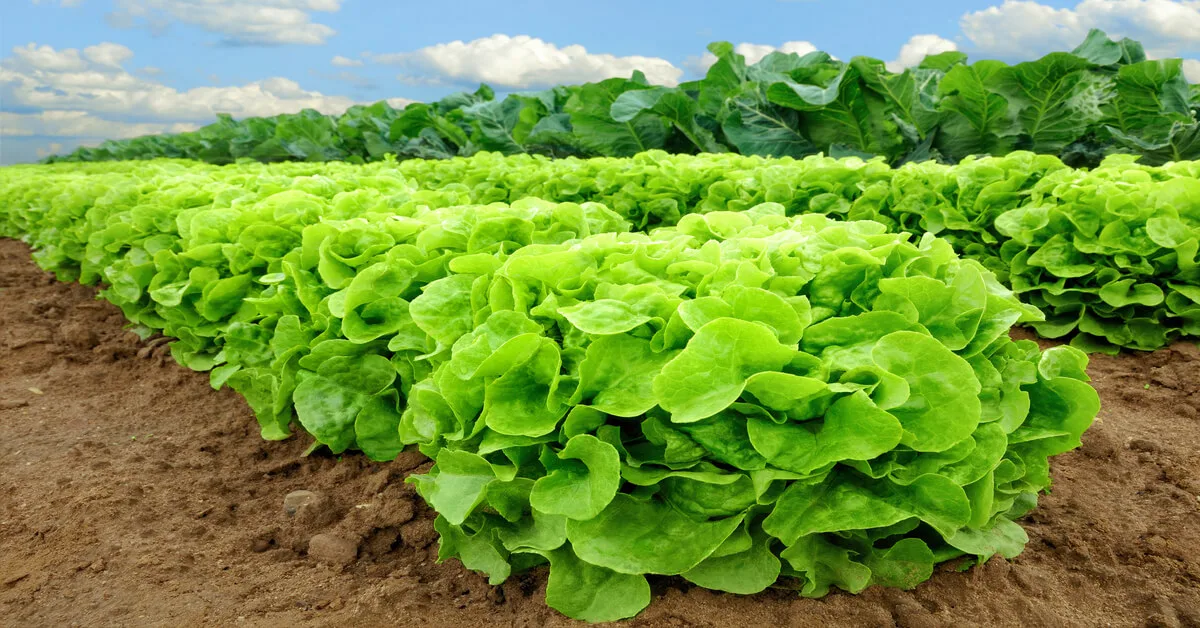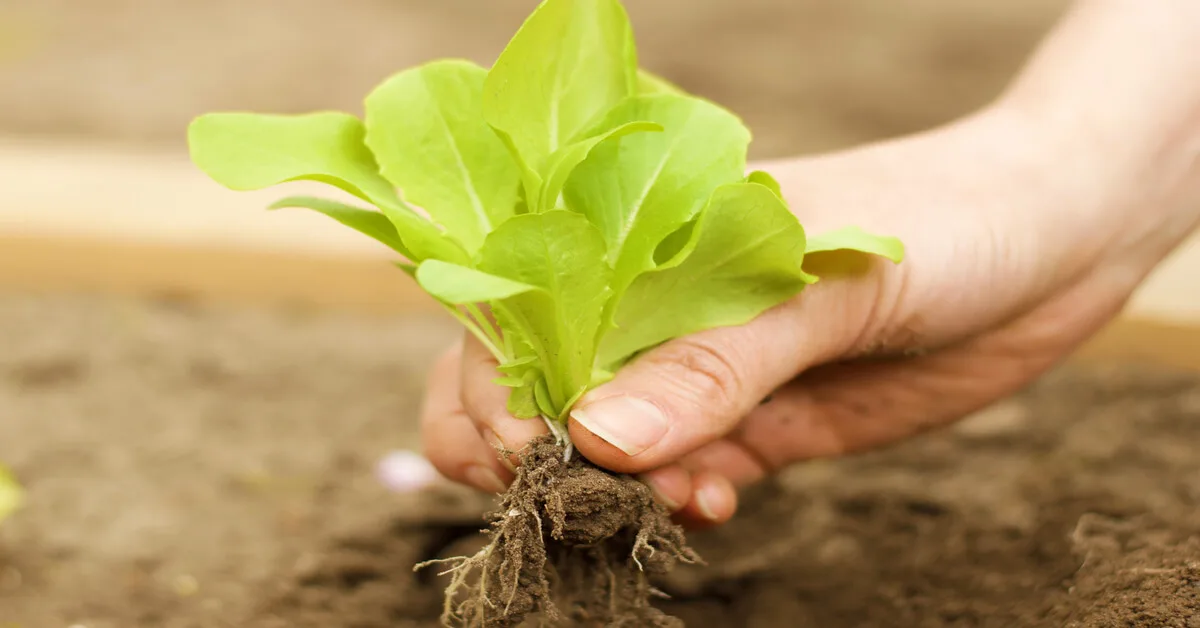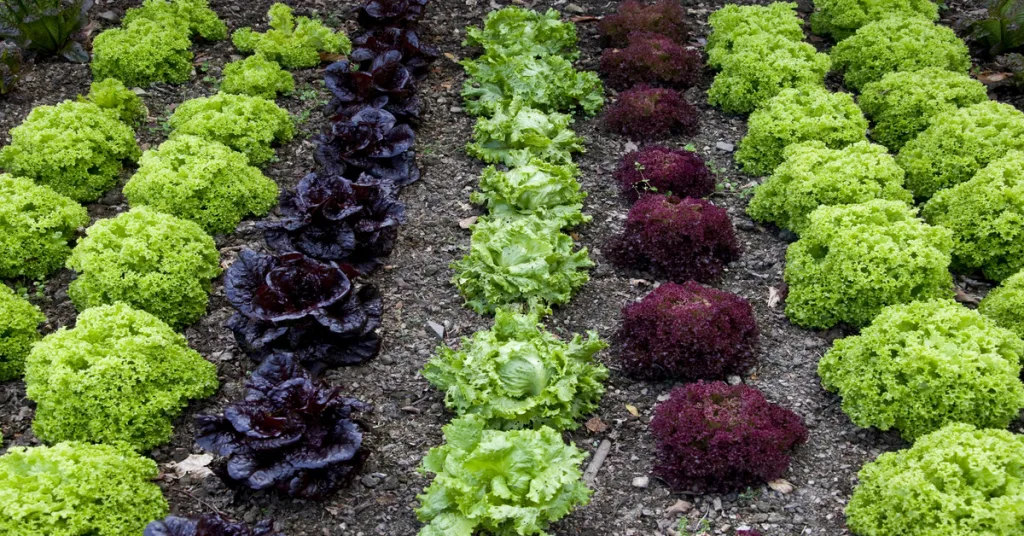Lettuce, scientifically known as Lactuca sativa, is an annual vegetable. It is a part of the Asteraceae family and has four main varieties. Its cultivation may predate ancient Egypt 6,000 years ago.
Throughout this article, you will find all the information you need to know to plant and grow lettuce.
History & Origin of Lettuce
Lettuce comes from the Mediterranean region and has been in cultivation for at least 6,000 years. Its cultivation dates back to Ancient Egypt; the vegetable is even in some tomb paintings.
But, despite little documentation, the vegetable may have been cultivated sooner. It is possible that cultivation began in the Middle East prior to Ancient Egyptian times.
Like many vegetables, the plant was once a wild-growing entity. Before its cultivation, lettuce was merely a weed.
Lettuce Plant Care

Lettuce makes a wonderful and healthy addition to any vegetable garden. But to successfully grow it, you will need to understand proper lettuce plant care.
From soil temperatures to fertilizing needs, below is everything you need to know!
Soil
For your lettuce seed and plants to flourish, you should grow them in sandy loam soil. The soil should also have a pH of 6.0 to 6.5.
Watering
Due to the plant’s shallow roots, it requires frequent watering. You will need to water the plant at least twice a week. Although, some dryer locations may require daily morning waterings.
Lighting
Lactuca sativa thrives when given five to six hours of sunlight a day. If you live in a location that has sweltering summers, they will need some afternoon shade.
Humidity & Temperature
To germinate the seeds, soil temperatures should be 60 to 80 degrees Fahrenheit or 15.56 to 26.67 Celsius. But the temperature should not exceed 95 degrees Fahrenheit or 35 degrees Celsius. After germination, temperatures should be 55 to 65 degrees Fahrenheit or 12.78 to 18.3 Celsius.
Fertilizing
If you do not want to take a soil pH test, simply apply NPK at a 5-10-10 ratio. It is best to apply three pounds of NPK per 100 sqft. It is also best to sidedress the plant. To sidedress, use a 15-0-0 ratio of calcium nitrate during the growing season for this process.
Diseases & Pests
There are several diseases that can affect Lactuca sativa plants. Those diseases include leaf spot, downy mildew, tomato spotted wilt virus, lettuce mosaic virus, bottom rot, and drop. They can also suffer from bacterial diseases. There are chemical, biological, and cultural methods of handling these diseases[1].
Caterpillars, snails, and slugs are troublesome insects for Lactuca sativa plants. All of them enjoy eating the fresh leaves. Cutworms, leafminers, whiteflies, cabbage loopers, and aphids can also affect the plant. Companion planting can help keep some of these pests at bay.
Days to maturity
How many days it will take for lettuce plants to mature depends on the variety you grow. But typically, most varieties mature between 30 and 70 days.
Harvesting
Harvesting occurs once the plant reaches maturity and before it begins to bolt. To harvest your lettuce, you can either dig up the whole plant or cut the plant 1″ above the soil surface. After harvesting, remove the dirt and store it in your refrigerator.
How to Plant Lettuce

There are many options for ways to plant lettuce. Succession planting lettuce is a popular way to create a bountiful harvest quickly. Planting seeds in a sqft garden is also a common method for home gardeners. But before diving into gardening styles, it’s best to understand how to plant lettuce.
When to Plant
If directly sowing, plant when the soil is 60 to 80 degrees Fahrenheit or 15.56 to 26.67 Celsius. When direct transplanting, ambient temperatures should be 55 to 65 Fahrenheit or 12.78 to 18.3 Celsius.
Where to Plant
You should plant your seeds or plants in a location that receives five to six hours of sun. The location should also have sandy loam soil.
How to Plant
For direct sowing, you will need to place the seeds 1/8 to 1/4 into the soil. Lettuce plant spacing should be at least 6″ apart. And you will need to water after planting.
Lettuce Growing Stages
Lactuca sativa plants have six growing stages. But if you are growing to consume the vegetable, there are only five. The sixth stage should be avoided.
Planting
Seed sowing should occur two weeks after the last frost date in spring. Although, you can start the seeds indoors if you want to grow the plant sooner.
Germination
Like all plants that grow directly from seed, there is a germination period. The germination period for lettuce seeds is two to fifteen days after planting.
Seedling
Before developing large foliage, your plant will enter the seedling stage. This stage is where you will start to see cotyledons, also known as seed leaves. During this stage, many gardeners opt to thin the plant out so there is at least 6″ between each leaf. Snails are also a prevalent pest during this stage, they like to nibble on the small leaves.
Foliage Development
When foliage development occurs, the base, also known as the head, is dense and the leaves grow and begin to cup.
Harvest
And finally, we have the harvesting stage. You can harvest the plant once it reaches maturity. How long it takes for your plant to mature will depend upon the variety. Iceberg matures in 50 to 90 days, while romaine takes 60 to 80 days.
Bolting
Now, we reach the sixth stage. If you do not harvest your lettuce once it matures, it will reach the end of its lifecycle and bolt. When it bolts it will grow flower stalks and become bitter in taste.
Types of Lettuce
The types of Lactuca sativa plants you can grow goes far beyond what you see on supermarket shelves. There are four main types of lettuce that every cultivator falls into, let’s dive into what those are.
Butterhead
Some butterhead varieties include Bibb and Boston. These varieties are known for their cabbage-like shape, cupping leaves, and smooth texture.
Crisphead
The most infamous variety of crisphead lettuce is iceberg. This variety is known for its pale and sweet inner leaves.
Romaine
There are many cultivators of romaine. Some of the best varieties include little gem and sparx. Romaine cultivators are known for their narrow leaves, thick ridge stalks, and bitterness.
Loose-leafand
Loose-leafand or loose-leaf lettuce is one of the most common varieties to grow in home gardens. Loose leaf lettuce cultivators are mild and sweet and have dark green to maroon coloring. One of the most common cultivators of loose-leafand lettuce is Oak leaf.
Lettuce Companion Plants
If you want to grow lettuce, the good news is that there are many complementary plants that you plant with it. Maximize space and keep pests away by companion planting lettuce with these plants.
Onions, Beets, and Carrots
If you want to maximize the space you have in your garden, consider planting onions, beets, or carrots. Unlike lettuce, beets, onions, and carrots have deep roots. These plants help you get the most out of your garden space.
Mint, Chervil, and Calendula
If you want to keep one of lettuce’s number one pests at bay, plant mint, chervil, or calendula. All three plants attract slugs away.
Garlic, Nasturtiums, and Chives
To keep aphids away, plant garlic, chives, or nasturtiums. Garlic, chive, and nasturtiums can deter aphids.
Lettuce vs Cabbage
The main difference between lettuce and cabbage is their color and texture. Lettuce is brighter green because of its higher chlorophyll content. It is also more oblong in shape and has easy-to-remove leaves. Cabbage is rounder with short stems and has harder to remove leaves that are tightly wound.
References:
[1] Lettuce disease management. UF/IFAS Extension: Solutions. (n.d.). Retrieved January 9, 2023.

